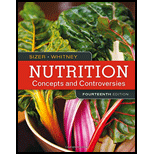
Nutrition: Concepts and Controversies
14th Edition
ISBN: 9781305886865
Author: Sizer, Frances , WHITNEY, Ellie
Publisher: Cengage Learning
expand_more
expand_more
format_list_bulleted
Question
Chapter 7, Problem 10SC
Summary Introduction
Introduction:
Vitamin E is a fat-soluble vitamin, which does an essential function as an antioxidant in the body. It is found specifically in foods, which comprises fat like, vegetable oil, margarine, nuts, wheat germ, seeds, and butter.
Expert Solution & Answer
Trending nowThis is a popular solution!

Chapter 7 Solutions
Nutrition: Concepts and Controversies
Ch. 7 - Prob. 1RQCh. 7 - Prob. 2RQCh. 7 - Prob. 3RQCh. 7 - Prob. 1CTCh. 7 - Prob. 2CTCh. 7 - Prob. 1SCCh. 7 - Prob. 2SCCh. 7 - Prob. 3SCCh. 7 - Prob. 4SCCh. 7 - Prob. 5SC
Ch. 7 - Prob. 6SCCh. 7 - Prob. 7SCCh. 7 - Prob. 8SCCh. 7 - Prob. 9SCCh. 7 - Prob. 10SCCh. 7 - Prob. 11SCCh. 7 - Prob. 12SCCh. 7 - Prob. 13SCCh. 7 - Prob. 14SCCh. 7 - Prob. 15SCCh. 7 - Prob. 16SCCh. 7 - Prob. 17SCCh. 7 - Prob. 18SCCh. 7 - A deficiency of niacin may result in which...Ch. 7 - Prob. 20SCCh. 7 - Prob. 21SCCh. 7 - Prob. 22SC
Knowledge Booster
Similar questions
- ________ is mostly plasma. a. Adipose tissue c. Cartilage b. Blood d. Bonearrow_forwardWhat kind of muscle tissue is found surrounding the urinary bladder? a. cardiac b. skeletal c. striated d. smootharrow_forwardIn a popular magazine article the author reports health benefits attributed to a particular dietary supplement. What kinds of evidence should the article cite to help you decide whether the information is likely to be accurate?arrow_forward
- A flexible, rubbery protein in connective tissue is called ___, whereas a more fibrous, less flexible glycoprotein is called ___. a. adipose; cartilage b. endocrine; exocrine c. sweat; hormones d. chondroitin sulfate; hydroxyapatite e. elastin; collagenarrow_forwardDoes physical exercise to increase muscle mass involve anabolic and/or catabolic processes? Give evidence for your answer.arrow_forwardBasal metabolic rate is a measure of ______. a. the total amount of calories you burn in 24 hours b. the amount of food energy needed to sustain basic body operations c. the amount of energy burned by skeletal muscle in a given period d. both a and barrow_forward
- Which of the following activities is not carried out by every cell in the body? Obtaining O2 and nutrients Performing chemical reactions to acquire energy for the cells use Eliminating wastes Largely controlling exchange of materials between the cell and its external environment Reproducingarrow_forwardThe four primary types of tissue are __________________, _________, _________, and __________________.arrow_forward
arrow_back_ios
arrow_forward_ios
Recommended textbooks for you
 Human Physiology: From Cells to Systems (MindTap ...BiologyISBN:9781285866932Author:Lauralee SherwoodPublisher:Cengage Learning
Human Physiology: From Cells to Systems (MindTap ...BiologyISBN:9781285866932Author:Lauralee SherwoodPublisher:Cengage Learning
 Human Biology (MindTap Course List)BiologyISBN:9781305112100Author:Cecie Starr, Beverly McMillanPublisher:Cengage Learning
Human Biology (MindTap Course List)BiologyISBN:9781305112100Author:Cecie Starr, Beverly McMillanPublisher:Cengage Learning

Human Physiology: From Cells to Systems (MindTap ...
Biology
ISBN:9781285866932
Author:Lauralee Sherwood
Publisher:Cengage Learning





Human Biology (MindTap Course List)
Biology
ISBN:9781305112100
Author:Cecie Starr, Beverly McMillan
Publisher:Cengage Learning